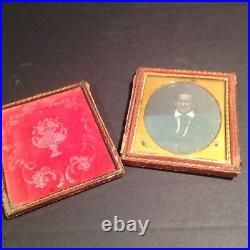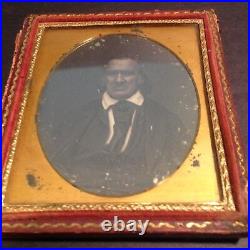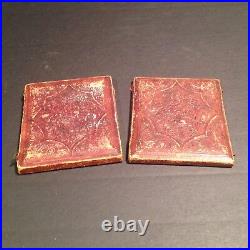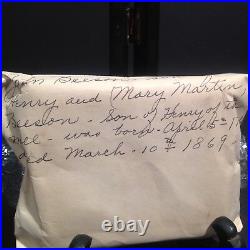




Vintage/Antique Daguerreotype Portrait – The Daguerrotype isat least 150 years old and most likely older. The handwritten province states John Beeson son of Henry and MaryMartin Beeson. Son of Henry of themill. Was born April 5th, 1781. Died March 10th, 1869. Possibly from pre-statehood IndianTerritory/Oklahoma. Enclosed in a woodencase covered with leather stamped with a relief pattern. The leather hinge is not intact. However, the latches on the opposite edge areintact. The inside of the cover is linedwith cut red velvet. The glass is edgedwith gold metal with painted gold scrollwork around the leather/woodframe. The case is 3 5/8″ x 3 1/8″ whenclosed. The case shows some wearconsistent with it’s 150+ year old age. The Daguerreotype is a. (daguerréotype) process, ordaguerreotypy, that was the first publicly available. Process, and for nearly twenty years it was the one most commonly used. And introduced worldwide in 1839, daguerreotype wasalmost completely superseded by 1860 with new, less expensive. Yielding more readily viewable images. To make the image, a daguerrotypist would polish a sheet of. To a mirror finish, treat it with fumes that made its surface light sensitive. For as long as was judged to be necessary, which could be as little as a fewseconds for brightly sunlit subjects or much longer with less intense lighting;make the resulting. On it visible by fuming it with. Vapor; remove its sensitivity to light by liquid chemical treatment, rinse anddry it, then seal the easily marred result behind glass in a protectiveenclosure. And Britain, thetradition of preserving miniature paintings in a wooden case covered withleather or paper stamped with a relief pattern continued through to thedaguerreotype. Some daguerreotypists were portrait artists who also offeredminiature portraits. Black-lacquered cases ornamented with inset. The more substantial Union casewas made from a mixture of colored sawdust and shellac (the main component ofwood varnish) formed in a heated mold to produce a decorative sculpturalrelief. The word “Union” referred to the sawdust and varnishmixture-the manufacture of Union cases began in 1856. In all types of cases, the inside of the cover was lined with velvet or plush or satin to provide adark surface to reflect into the plate for viewing and to protect the coverglass. Some cases, however, held two daguerreotypes opposite each other. The cased images could be set outon a table or displayed on a. Most cases were smalland lightweight enough to easily carry in a pocket, although that was notnormally done.
